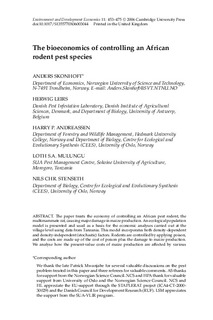The bioeconomics of controlling an African rodent pest species
Skonhoft, Anders; Herwig, Leirs; Andreassen, Harry Peter; Mulungu, Loth S. A.; Stenseth, Nils Christian
Original version
Skonhoft, A., Herwig, L., Andreassen, H., Mulungu, L., Stenseth, N. (2006) The bioeconomics of controlling an African rodent pest species. Environment and Development Economics, 11(4), 453-475 http://dx.doi.org/10.1017/S1355770X06003044Abstract
The paper treats the economy of controlling an African pest rodent, the multimammate rat, causing major damage in maize production. An ecological population model is presented and used as a basis for the economic analyses carried out at the village level using data from Tanzania. This model incorporates both density-dependent and density-independent (stochastic) factors. Rodents are controlled by applying poison, and the costs are made up of the cost of poison plus the damage to maize production. We analyse how the present-value costs of maize production are affected by various rodent control strategies, by varying the duration and timing of rodenticide application. Our numerical results suggest that it is economically beneficial to control the rodent population. In general, the most cost-effective duration of controlling the rodent population is 3–4 months every year, and especially at the end of the dry season/beginning of rainy season. The paper demonstrates that changing from today's practice of symptomatic treatment when heavy rodent damage is noticed to a practice where the calendar is emphasized, may substantially improve the economic conditions for the maize producing farmers. This main conclusion is highly robust and not much affected by changing prices of maize production.
